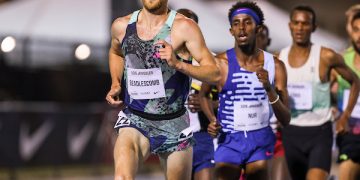This piece by Jeff Benjamin is about 1991 World Championship bronze medalist in the marathon Steve Spence. His patience in the first half of hot and humid Tokyo , and his pain staking move through the pack, until, just as he and the late Dr. David Martin had planned, putting him in contention with 2.5 miles to go!
Jeff Benjamin, RunBlogRun’s senior writer for the East Coast, provides us this view into Steve Spence’s iconic medal winning performance. It was at a time, when, well, American marathoners were not impressing many on the world stage!
Enjoy Jeff’s labor of love.
Steve Spence’s bronze medal in 1991 showed us that American male marathoners could race with the best in global championships.
1991 World Championship Men’s Marathon, (27 minutes) highlights
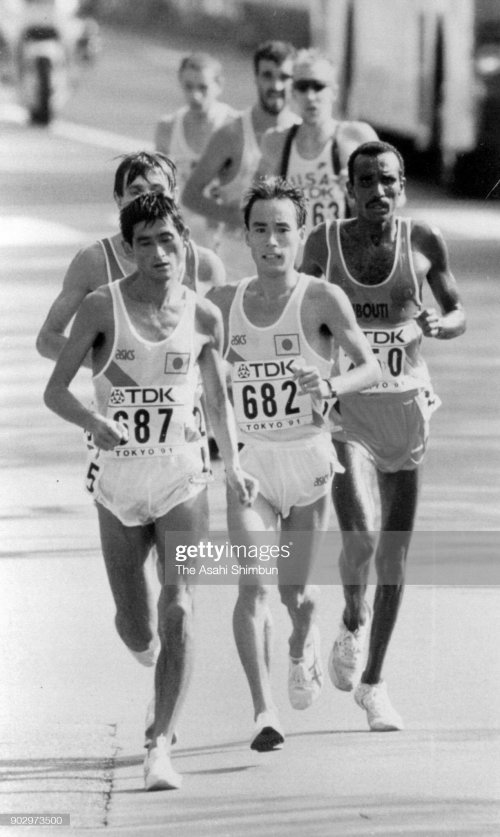 1991 World Championships Marathon, photo courtesy of the Asahi Shimbun /Getty Images
1991 World Championships Marathon, photo courtesy of the Asahi Shimbun /Getty Images
The 30th Anniversary Of USA Marathoner Steve Spence’s World Championship Bronze Medal!
By Jeff Benjamin
Towards the tail-end of the summer of 1991, Track fans tuned into NBC’s coverage of the 3rd annual World Track & Field Championships hosted by the city of Tokyo.
Over the almost 2-week period American fans no doubt cheered the record-breaking performances of Mike Powell, Carl Lewis
Towards the conclusion of these stellar events came the Men’s Marathon, which would be contested in enormously hot and humid conditions. But that didn’t stop the World’s great distance runners from competing, among them 1988 Olympic Gold medalist Gelindo Bordin, 1985 World Cup Champion Ahmed Saleh, London & Rotterdam Champion Hiromi Taniguchi, along with Canadian Peter Maher, Australian Steve Moneghetti and Salvatore Bettiol of Italy among others.
During the late 1980’s and early 1990’s America was at the nadir of World-Class Marathoning. Gone quickly were the days of Bill Rodgers, Frank Shorter, Alberto Salazar and a huge depth of quality Marathon runners who went head-to head with the rest of the world.
Yet, on that hot Tokyo day toward the latter stages of the race, TV viewers saw Shippensburg running legend Steve Spence on the screen in the background of the lead pack with his USA singlet standing out!
Spence had dallied with the marathon in past attempts with no great success and in preparation for Tokyo enlisted the aid of Exercise Physiologist extraordinaire the Late David Martin.
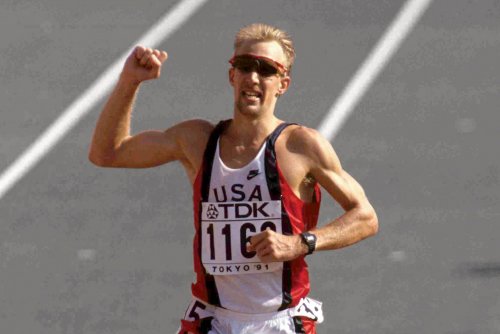 Steve Spence takes WC bronze in the 1991 marathon, photo courtesy of USATF
Steve Spence takes WC bronze in the 1991 marathon, photo courtesy of USATF
With less than 2 miles to go on that very hot day Spence, who started out the race way back in the pack, now put the hammer down, breaking away from Bordin and taking full advantage of the downhill slope he knew was coming.
On television, NBC viewers saw Taniguchi win Gold in his native country, clocking in at a time of 2:14:57 with Saleh (2:15:26) netting the Silver.
Then the announcer loudly exclaimed the figure of Spence, clad in his USA singlet and shirt, running into the stadium in 3rd, earning a tough Bronze medal and shaking his fist in the air!
For Spence to medal showed that American World-Class Marathoning was not dead, and that future stars could try to rise up like he did.
Now, 30 years later, Coach Spence, still at Shippensburg, looked back on that day and how he got onto the medal stand.
But one must go back to Spence’s first world-class marathon attempt at Boston in 1990.
1)Your 1990 Boston Marathon experience – how would you describe it?
Looking back, I see it as a great learning experience for me.I was in 4th at 23 miles and feeling great and then bonked and faded to 19th.I learned that I need to get better at glycogen loading, better at properly managing pace, and better at hydrating during the race.The failure left me searching for answers and for a new way of preparing and a desire to really pay attention to the details.In addition to the frustration of bonking in my 5th consecutive marathon, I had the disappointment of missing my daughter, Neely’s, birth.At the time it seemed like a good idea to go to Boston, but looking back I’m like “how dumb are you?”
2) How did you get acquainted with Dr. David Martin and what made you buy into his training ideas?
“I met Dr. Dave after I won the Jacksonville Gate River Run in 1988. He was on the lead truck with the press core and he was the only person who had a little background information to share about me as I moved into the lead at the 8 mile mark. We chatted after the race. I knew that my mentor, Jon Sinclair, was in Dr. Dave’s marathon development group. He contacted me shortly after that to come down to Atlanta for an evaluation and I jumped at the offer. Dave didn’t coach me or most of the athletes in the group, but rather provided important physiological information that helped guide our training. He also looked over my training plan and would offer recommendations. I think the only elite that he coached was Keith Brantly. Dave was brilliant. He had the gift of explaining physiological data in a way that a layperson like myself could understand. He assessed strengths and weaknesses and helped with a plan to improve in those areas. He evaluated his runners as whole people, taking into account each individual’s physical state, mental state, and life circumstances. I always felt incredibly motivated after spending a couple of days with Dr. Dave.”
3) In preparation for the 1991 World Champs what were some of your training methods that some would consider “unorthodox”?
1991 World Championships Marathon, photo courtesy of the Asahi Shimbun /Getty Images
“In addition to fine-tuning the details pertaining to race preparation and execution, I turned the last 12 weeks of my training plan upside down. At the advice of my agent, Don Paul, I did the bulk of my mileage at the end of the training block. My highest mileage week was 3 weeks prior to the marathon and my longest run was about 2 weeks prior to the race. Dr. Dave stressed that I didn’t need to be super fast because it would most likely be extremely hot. He stressed the building of aerobic strength and that I perfect fluid and pace management. Also, my strength coach, Doug Lentz, developed a plan for me that was somewhat aggressive with substantial weight. Doug collaborated with Dave on a plan for me which I feel kept me injury-free, increased my power, increased my stride length, and improved my running economy.”
4) Was there any kind of planning in regards to your competitors or just the challenge of a tough course on a hot day or perhaps both?
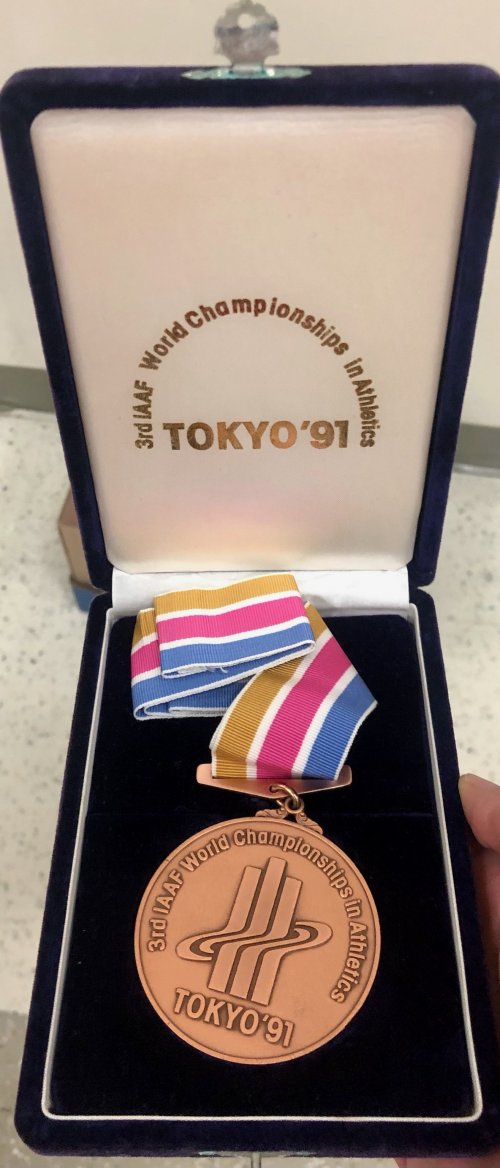 Steve Spence’s 1991 World Championships Marathon bronze medal, photo by Jeff Benjamin
Steve Spence’s 1991 World Championships Marathon bronze medal, photo by Jeff Benjamin
“Dr. Dave and I talked extensively and determined the specific time that we felt I could manage on that course taking into account the extreme heat and humidity. The goal was to lock into that pace from the start and to run my own race. My hope was that the race would go out very fast and I would work my way through the carnage.”
5) Describe your first 1/2 of the race up until 13 miles & did you confront any personal doubts?
“I locked into my pace and appropriate effort from the moment the gun sounded. Brad Hudson ran with me for the first 10 miles and then he had some intestinal issues and had to take a bathroom break. I continued on pretty much by myself and soon began to catch runners who mismanaged their pace. Passing runners built my confidence and I was about 1 minute behind the lead pack at the half. I got a good look at the lead pack at the turnaround and I could tell that my turnover was better than theirs. It was another boost of confidence and I felt that my goal of finishing top 10 was very realistic at that point.”
6) When did you have a true feeling that you were in medal contention and when did you realize you were in 3rd place?
Steve Spence takes WC bronze in the 1991 marathon, photo courtesy of USATF
“I could tell that I was gaining ground each mile after the turnaround and that bolstered my confidence. Also, I would see runners drop off the lead pack, and then shortly after that, I’d pass them. This included some of the prerace favorites. Just before I joined the lead pack at 23 miles, I thought I had a chance to win or medal. My thoughts were…get to the pack and then use the pack to get to the top of the impending hill and then drive for home the last 2.5 miles. I moved into 3rd shortly after cresting the half-mile hill and I was focused on trying to catch Ahmed Salah, from Djibouti, who had made the break with Hiromi Taniguchi.”
7) The famous photo on the cover of Running Times – could you explain the story behind it?
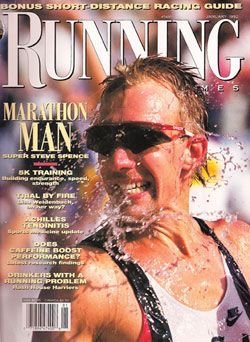 Running Times iconic cover of Steve Spence (photo credit: Victor Sailer / PhotoRun)
Running Times iconic cover of Steve Spence (photo credit: Victor Sailer / PhotoRun)
Yes. I was offered a bottle of water soon after crossing the finish line. I accepted, tilted my head back, and then poured the water over my face. Next, I shook my head and water droplets flew from my hair. A few seconds later, Victor Sailer said, “Steve, that was awesome, but I missed the shot. Can you do that again?” I gladly grabbed another bottle and repeated. That is when he got the shot.
8) What’s your take on World & American Marathoning today & what kind of advice can you give to young distance runners?
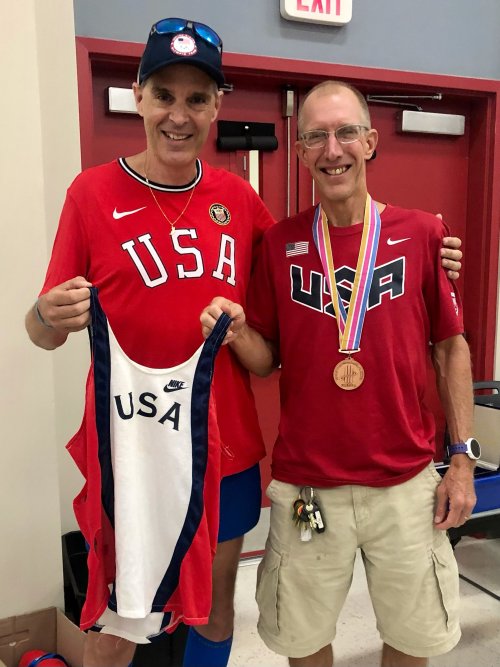 Senior Writer Jeff Benjamin with Steve Spence, holding the 1991 singlet and 1991 WC bronze medal, photo by Jeff Benjamin
Senior Writer Jeff Benjamin with Steve Spence, holding the 1991 singlet and 1991 WC bronze medal, photo by Jeff Benjamin
“I feel that the quality and depth of World and American marathoning is unprecedented. American distance running has exploded in the last 3 or 4 years. The quality and depth at the 5k and 10k is outstanding and it will be exciting to watch this crop of young talent as they transition to the marathon. I learned from Dr. Dave that each individual is an experiment of one, so I’m not real keen on giving a blanket statement of advice. I will however advise to keep it fun, be in touch with your higher power, be bold, and follow your heart.”
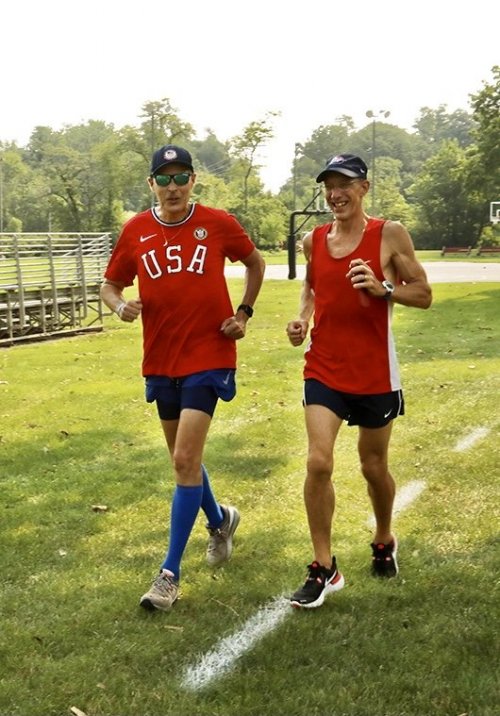 A bucket-list moment for The Running Network’s Jeff Benjamin as he joins Steve Spence for a run! photo by Jeff Benjamin
A bucket-list moment for The Running Network’s Jeff Benjamin as he joins Steve Spence for a run! photo by Jeff Benjamin
BELL LAP – Coach Spence – Who had run a sub 5 minute mile once a year for more than 4 decades and whosedaughter Neely became quite a runner herself! – Has annually put on the Shippensburg Running Camp for many years now – The all-inclusive camp is geared to the youth/high school runner, from beginner to elite.
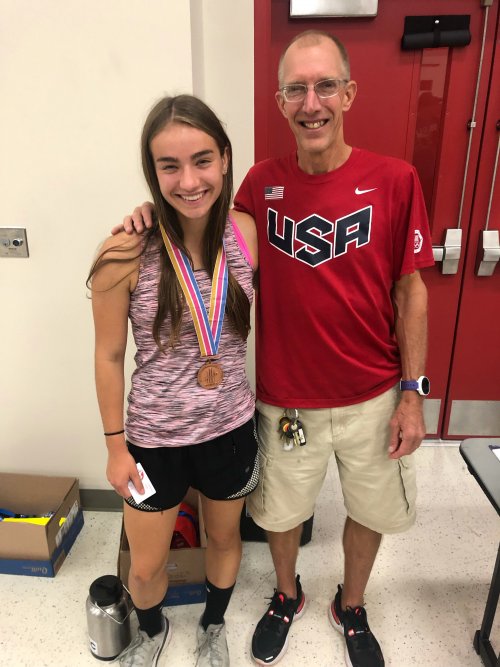 Coach Spence with camper Kyla Leathers at the 2021 edition of the Shippensburg XC summer camp, photo by Jeff Benjamin
Coach Spence with camper Kyla Leathers at the 2021 edition of the Shippensburg XC summer camp, photo by Jeff Benjamin
For further info on the Summer 2022 edition please go to –
https://camps.ship.edu/RaiderCamps/CampPrograms/Camp?code=CrossCountry
Author
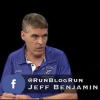
Jeff Benjamin has written for 30 years for American Track and Field along with RunBlogRun. The Former President of the Staten Island AC & Chair of the Staten Island Running Association was the 5th man scorer for his Susan Wagner High School NYC XC City Championship team. Also a member of the College of Staten Island Sports Hall of Fame for XC, Jeff currently serves as the LDR Chairman for USATF NY. A passionate (or fanatical) follower of the Sport, some of Jeff's subjects have included Sebastian Coe, Emma Coburn, Eamonn Coghlan, Matt Centrowitz, Jim Spivey, Galen Rupp, Joe Newton, Tom Fleming, Ajee’ Wilson, Bill Rodgers, Allan Webb, Abel Kiviat, Jordan Hassay, Marty Liquori, Caster Semenya, Rod Dixon, Carl Lewis and Jim Ryun as well as Book Reviews and articles covering meets and races in the Northeast U.S.
View all posts






